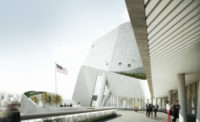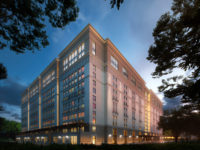If every journey begins with a single step, Seaport Square, a 23-acre mixed-use development along the Boston waterfront, is starting with a single-story building.
In early May, Mayor Thomas Menino held a groundbreaking ceremony for the Boston Innovation Center, an angular, 12,000-square-foot structure designed by local architects Hacin + Associates and budgeted at $5.5 million. The building will give tech masterminds a place to meet with venture capitalists—much as they do at the successful Cambridge Innovation Center, across the Charles River and adjacent to MIT.
The center may soon be dwarfed by other components of Seaport Square, including office, hotel, and residential buildings expected to total some 3.5 million square feet. But with the city branding Seaport Square as an “innovation district"—part of a larger initiative to draw tech companies to Boston—it may be the neighborhood's symbolic heart. The center’s facades, of corrugated metal, will support two large LED signs that will promote events at the facility, as well as provide a revenue stream from advertising. Inside, all of the walls will be covered by whiteboards or blackboards. “It’s going to be a completely ‘writable’ building, almost like a big work surface,” says architect David Hacin.
The Innovation Center will be a counterpoint to the massive buildings called for in Seaport Square’s master plan, designed by Kohn Pedersen Fox with input on retail facilities by ADD Inc. Once a Penn Central rail yard, the site is now a vast expanse of parking. (Diller Scofidio + Renfro’s Institute of Contemporary Art and Pei Cobb Freed’s Moakley Federal Courthouse are neighbors.) In January, the Boston Redevelopment Authority gave the developer—a partnership of Boston Global Investors and Morgan Stanley—permission to begin construction of the multi-billion-dollar project. According to John Hynes, the CEO of Boston Global Investors, though the Innovation Center is the only structure now under construction, the permit process has begun for five other buildings. Groundbreaking is slated for early 2013.
James Von Klemperer, a KPF principal, says the master plan continues existing street grids into the new development, as if historic neighborhoods were knitted together. The scheme also turns the entire site into a ramp of sorts, so that a 25-foot grade change will no longer create barriers to pedestrian movement. Although the development will contain only half as many square feet as New York’s Hudson Yards—another KPF project on roughly the same number of acres—height restrictions on the approach to Logan Airport mean the buildings will have to top out at 250 feet, resulting in wide blocks at ground level. According to Hacin, the development’s smaller buildings, such as his Innovation Center, will help “establish a granular human scale to this district.”
In addition to the new buildings, the development will host a new green plaza—the namesake square—designed by Reed Hilderbrand, the Boston landscape architecture firm. The plaza will serve as a community space, much like New York’s Bryant Park, of which KPF’s Richard Nemeth cited as inspiration.
The Seaport Square project is not without contention. As part of the state’s environmental permitting process, the developer agreed to build a small park in front of the Boston Children’s Museum, on Fort Point Channel, in exchange for the right to construct a hotel on the channel. But the Children’s Museum, citing budget shortfalls, has not yet contributed a design for the park. Meanwhile, the Boston Redevelopment Authority has asked the state to let the hotel proceed anyway.
That leaves Vivien Li of the Boston Harbor Association, an advocacy group, concerned. “We are pushing for the developer to provide adequate funds for the development of the park, on a timetable consistent with the requirement the park be built first,” she said. Hynes confirmed that “the park is in limbo” but said that “as the commercial projects get developed, so too will the public amenities.”







